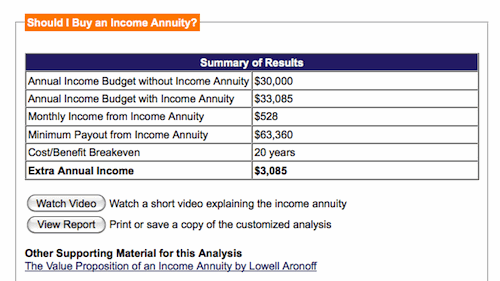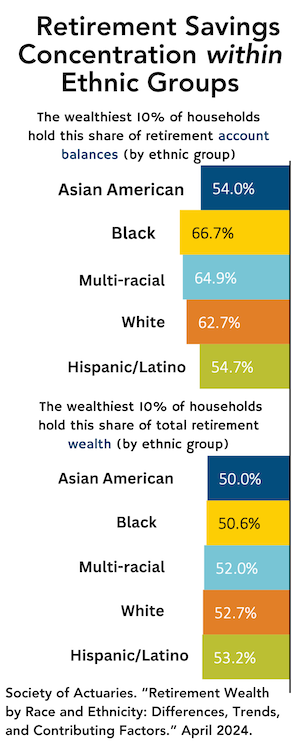
Have you ever been hit by a bus? Have you ever known anyone who was hit by a bus—a city bus, school bus, charter bus, or any of the hundreds of buses that pass through New York’s Port Authority Terminal every day?
Probably not. So why do some people cut short virtually every conversation about income annuities with the dismissal, “Yeah, but what if you got hit by a bus the day after you bought one?”
Clearly, the bus analogy is a bit passé. Advisors who understand decumulation know that including an income annuity in a retirement plan doesn’t have to imply a zero-sum showdown between your clients and the issuer of the contract—or a bus driver.
The annuity decision is more nuanced than that. Those nuances include sub-decisions about how much money to annuitize, when to annuitize it and how best to customize the annuity contract so that it gives the client more financial freedom in retirement, not less.
Cannex, the Canadian-American firm that gathers annuity pricing data from issuers and distributes it by subscription to broker-dealers and other institutions via its Retirement Income Product Exchange, has recently added tools to its website that can help advisors explore the nuances of the annuity purchase.
In this article, we’ll take a brief tour of Cannex’s new tools. These include calculators that allow planners to get price quotes for and run simulations on single-premium immediate annuities (SPIAs) and also to get quotes on the suddenly popular deferred income annuities. Educational resources are also offered.
The most noteworthy of the new tools and features may be a marketing video that advisors can use in presentations to retirement income clients. Created with the help of annuity guru Moshe Milevsky and the Toronto production company Blue Rush, the videos are linked to one of the calculators. That enables an advisor to tailor a video for every client by populating the video with the data from a specific projection or simulation.
The tools are intended, obviously, to help advisors manipulate the data that their broker-dealers buy from Cannex. Though self-serving in that sense, the tools are highly robust, product-neutral, and help answer the key questions that advisors and their clients bring to discussions of income annuities. If you are among the 200,000 or so advisors who have access to the password-protected Cannex site, here’s a summary of what you’ll find. Even if you’re not, a tour of the site might be worthwhile.
‘Should I Buy an Income Annuity?’
After the initial landing page on the Cannex site (which asks you to choose the Canadian or U.S. edition), visitors will see a link called Cannex tools under the heading “Product education.” The next page offers four links, the first of which is labeled “Should I Buy an Income Annuity?” (See illustration below.)
The calculator on this page should feel familiar. It resembles the annuity price quote tools offered at some direct-to-consumer income annuity sales sites where the end-purpose is to generate sales leads for phone banks of licensed insurance agents. The Cannex calculator will, in fact, let you input the age, state, premium amount and contract type and generate a payout rate.
 This calculator shows off an income annuity’s best feature: its ability to maximize safe income during retirement. It allows the advisor to see how much extra income his client could get each year by buying an income annuity with part of his savings, compared with the income generated by an equally safe 4% withdrawal strategy.
This calculator shows off an income annuity’s best feature: its ability to maximize safe income during retirement. It allows the advisor to see how much extra income his client could get each year by buying an income annuity with part of his savings, compared with the income generated by an equally safe 4% withdrawal strategy.
A single 65-year-old man with $500,000 in savings, for instance, could spend $23,085 a year if he put $100,000 in a life-with-10-year-certain SPIA and drew 4% a year from the other $400,000 just as safely as he could spend $20,000 by drawing 4% from the whole $500,000.
Indirectly, the calculator reveals the “mortality credit” of the annuity. Also called the “survivorship credit,” that’s the premium that comes from outliving fellow life annuity owners.
This tool also provides a link to the video described above, automatically embedding the data from the calculator into each video. (Below, a screen capture from the video.) The advisor can also access price quotes from the Cannex database through this page, and link to an article about income annuities by Cannex CEO Lowell Aronoff.
 The real-time price quotes are important, because they show how much the payout amounts quoted by different carriers at any given time can vary. The monthly income quotes on the hypothetical $100,000 contract described above ranged from a low of $348 a month to a high $412 a month.
The real-time price quotes are important, because they show how much the payout amounts quoted by different carriers at any given time can vary. The monthly income quotes on the hypothetical $100,000 contract described above ranged from a low of $348 a month to a high $412 a month.
The ILY and the IRR
The second and third tools help advisors quantify two factors—an annuity’s Implied Longevity Yield (ILY) and its Internal Rate of Return (IRR). They too indirectly express the value of the mortality credit.
A creation of Dr. Milevsky’s QWeMA Group, the ILY helps the advisor decide whether a retiree should buy an income annuity today or wait several years and use a systematic withdrawal plan to provide income in the meantime.
An ILY of 3.9% over a 10-year waiting period, for instance, would mean that if a 65-year-old client knew he could earn more than 3.9%—risk-free—on his investments over the next 10 years, then he should draw income from those investments during that time and delay the annuity purchase for 10 years. If not, he should put that money in an income annuity today. The ILY goes up over time; if you changed the age of the client to 75 in this example, his ILY would rise to 4.7%.
The IRR of any specific annuity can also be calculated on the Cannex site. Most advisors want to know the IRR of an annuity over the average life expectancy, so they can compare it to the investment return they think they can achieve for a client during the time.
But that approach misses the point, for two reasons. First, the IRR is always a guesstimate because nobody knows when the annuitant will die. The longer he or she lives, the higher the IRR. Second, an IRR isn’t the most helpful yardstick for gauging the value of an annuity, because an annuity isn’t an investment. It is insurance—insurance against the risk of outliving one’s life expectancy.
The Cannex calculator works around this problem by offering three sample IRRs for each annuity. For instance, a 65-year-old New York man with a $100,000, single life-with-10-year-certain annuity would have an IRR of 3.26% if he lived to his average life expectancy (84). But his IRR would be 4.83% if he lived to age 94 (thus outliving 75% of his peers) and 5.50% if he lived to 100 (outliving 90% of his peers).
Notice the fairly narrow range between 3.26% and 5.50%. The older you are when you buy the annuity, the wider the range and, therefore, the greater the chance that the annuity will either pay off big or not at all. If you changed the New York man’s age-at-purchase to 75, his IRR at life expectancy (age 88) would be just 0.76%. At the 75th percentile (age 94), it would be 4.94%. At the 90th percentile (age 100), it would reach 6.61%. Again, it’s an indirect expression of the potential value of the mortality credit.
What type of income annuity is right for me?
Assuming that the advisor and client have gotten through the first three calculators and know how much money they want to spend on the annuity and when they want to buy it, the fourth tool on the website allows the advisor and client to compare the payout rates of different contract designs.
An advisor can input a client’s information—age, state of residence, amount of premium, sex and preference for a single or joint-life contract—and then see how much a life-only contract, a life-with-10-years-certain, a life-with-20-years-certain and life-with-cash-refund would pay, respectively.
This type of exercise will generally show a 65-year-old client and spouse—perhaps to their pleasant surprise—that an average joint-life-with-20-year-period-certain contract (which guarantees that they or their beneficiaries will get their principal back and more) will deliver only slightly less income per month than a joint-life only ($453/month versus $445/month per $100,000 premium), where the income ends when both spouses have died, even if they die shortly after they buy the contract.
That’s another indirect measure of the mortality credit—or, in this case, the lack of one. The insurance companies are evidently confident that at least one member of a 65-year-old couple that seeks out an annuity will live at least 20 years. (Annuity buyers tend to be healthier than average Americans.) Consequently, the life-only contract pays just $8 a month more than the 20-year-period-certain contract.
Rules-of-thumb work too
As noted above, only advisors affiliated with institutions that subscribe to Cannex will have access to these tools. This article may therefore seem unnecessarily long. But the four Cannex tools themselves, although proprietary, nonetheless provide an opportunity for a general review of some of the most important elements of the annuity purchasing decision.
It should be noted that calculators of this type are subject to their own law of diminishing educational returns. There’s an ever-present temptation to use them to churn out overly precise results on the basis of a few arbitrary assumptions about, say, future market returns or longevity.
There’s also an ever-present risk of using them to breed an overwhelming number of optional solutions to a problem, or of creating trade-offs so finely balanced that they would prevent King Solomon from making a decision. Sometimes, when faced with the unknowable, heuristics (i.e., rules-of-thumb) work just as well or better.
When shopping for an income annuity, a fairly safe default strategy for the typical mass-affluent couple would be to buy a joint-life annuity with 10, 15 or 20 years certain that generates just enough income, along with Social Security and other reliable sources of lifetime income, to cover all their basic expenses from age 70 or so onward. One final note: it’s absolutely essential to know the entire range of market prices of annuities at the time you buy. Buying blind could cost your client a small fortune.
© 2013 RIJ Publishing LLC. All rights reserved.


